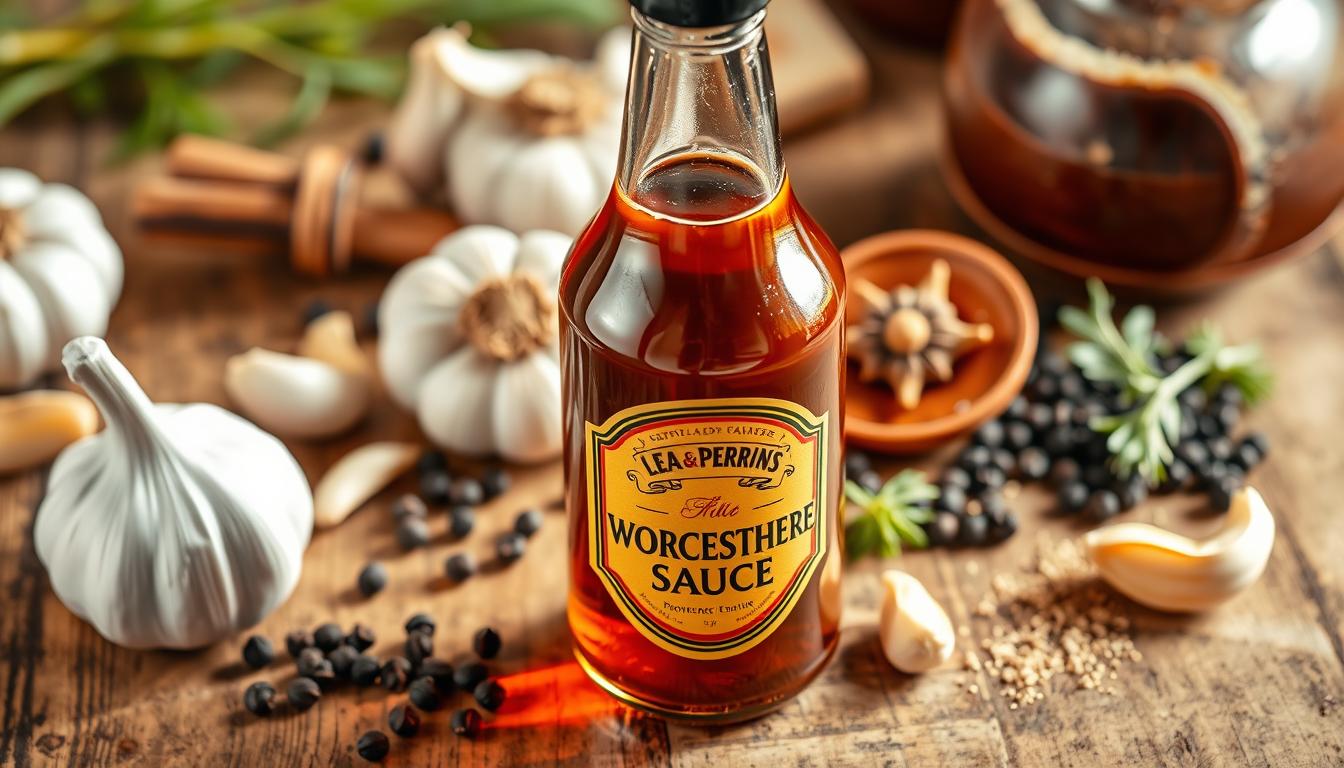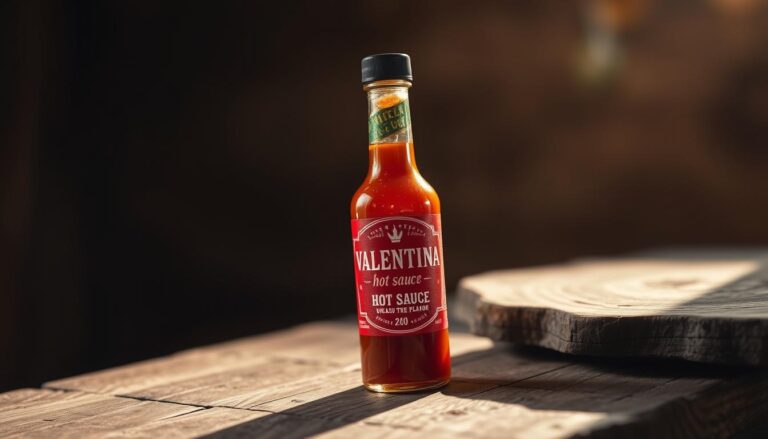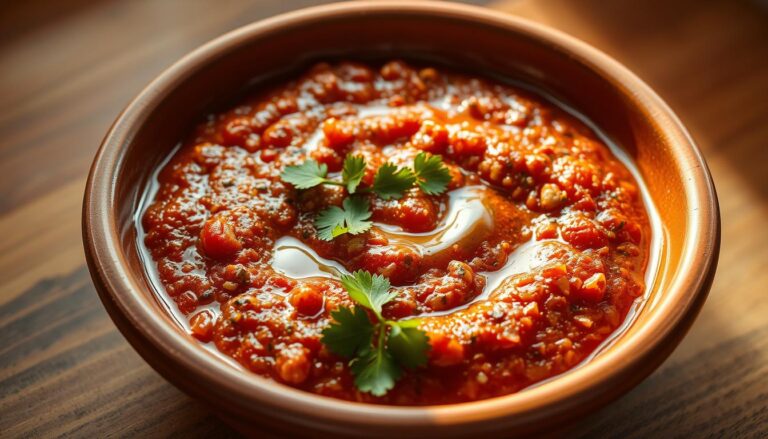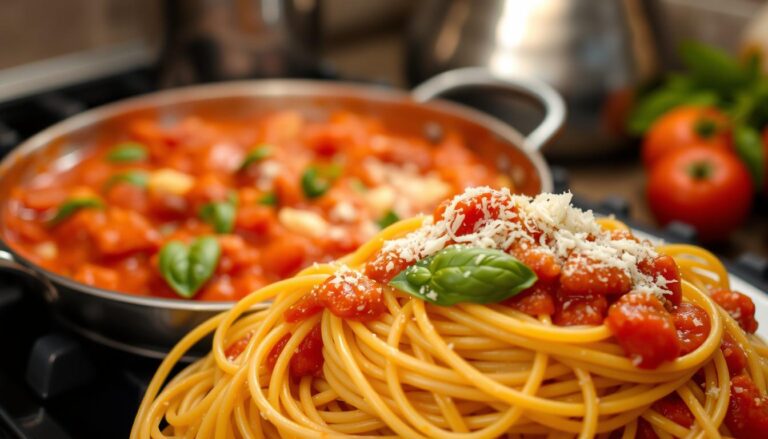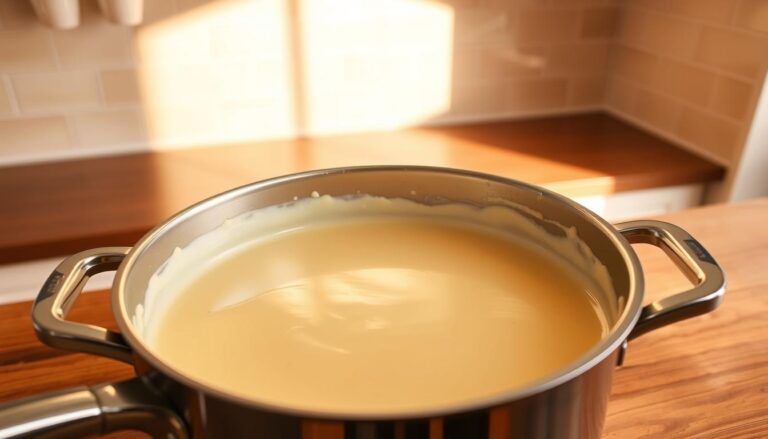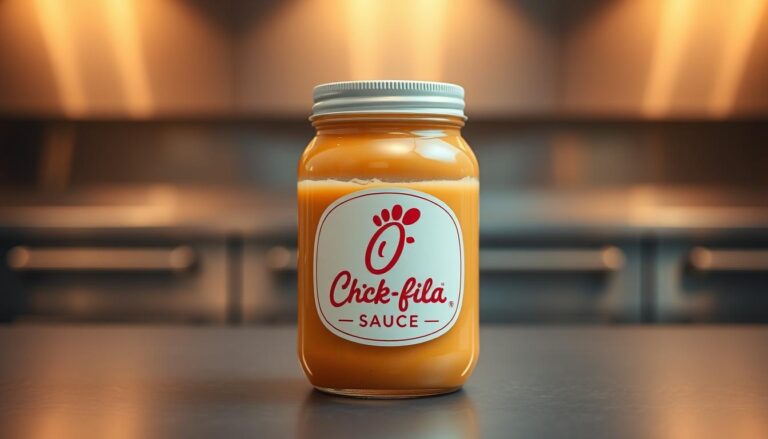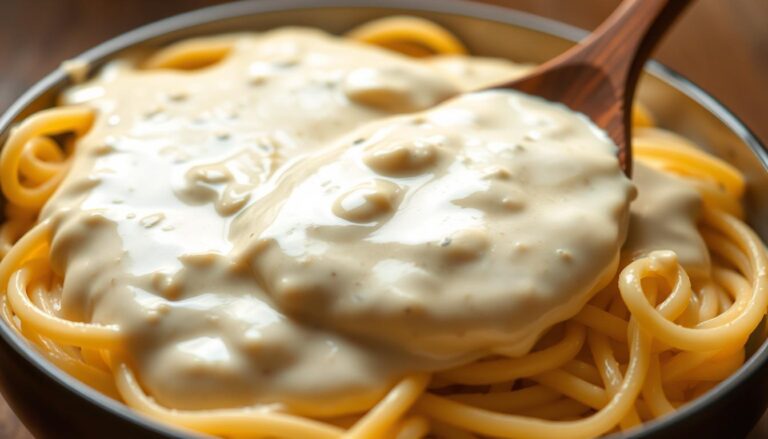Worcestershire Sauce: Elevate Your Dishes
Elevate your cooking with the rich flavor of Lea & Perrins’ iconic condiment. For centuries, Worcestershire sauce has been a staple in kitchens around the world, adding depth and complexity to a variety of dishes.
This savory condiment is made from a secret blend of ingredients, carefully crafted to enhance the flavor of meats, soups, and stews. Whether you’re a seasoned chef or an amateur cook, incorporating Lea & Perrins into your recipes can take your dishes to the next level.
Key Takeaways
- Discover the rich history behind Lea & Perrins’ Worcestershire sauce.
- Learn how to use this versatile condiment in various recipes.
- Explore the benefits of incorporating Lea & Perrins into your cooking routine.
- Understand the significance of Lea & Perrins as the original Worcestershire sauce brand.
- Find out how to elevate your dishes with the unique flavor of Lea & Perrins.
The Rich History of Worcestershire Sauce
The origins of Worcestershire sauce are deeply intertwined with the history of Lea & Perrins, its pioneering manufacturer. The story begins in the early 19th century when Lord Marcus Sandys, the former Governor of Bengal, commissioned the creation of a sauce reminiscent of the flavors he encountered in India.
The Lea & Perrins Origin Story
The task fell to Lea & Perrins, a local pharmacy in Worcestershire, England. The chemists at Lea & Perrins worked on concocting the sauce, leading to the accidental discovery of a unique blend.
The Accidental Discovery
Left to mature in a cellar, the mixture fermented, creating a distinct flavor profile that became the hallmark of Worcestershire sauce. This serendipitous discovery was the beginning of a culinary phenomenon.
From Medicine to Condiment
Initially marketed as a health tonic, the sauce soon gained popularity as a condiment. Its versatility in enhancing various dishes contributed to its widespread acceptance.
How Worcestershire Sauce Became a Global Condiment
The global spread of Worcestershire sauce can be attributed to colonial expansion. As British trade and influence grew, the sauce traveled to new regions, adapting to local cuisines.
Colonial Expansion
British colonizers introduced Worcestershire sauce to various parts of the world, where it was incorporated into local recipes. This exposure helped in establishing the sauce as a global condiment.
Modern Popularity
Today, Worcestershire sauce is a staple in many cuisines around the world. Its unique flavor has made it a favorite among chefs and home cooks alike. As noted by a culinary expert,
“Worcestershire sauce adds a depth of flavor that is hard to replicate with other ingredients.”
The history of Worcestershire sauce is a testament to its enduring appeal. From its origins with Lea & Perrins to its current global status, the sauce has come a long way, enriching culinary traditions worldwide.
What Is Worcestershire Sauce Made Of?
Worcestershire sauce is a savory condiment composed of various ingredients, including some that might surprise you. At its heart, the sauce is a complex blend of flavors that have been perfected over centuries.
Traditional Ingredients
The traditional recipe for Worcestershire sauce includes a variety of key ingredients. Two of the most significant components are anchovies and fermented fish, which provide the sauce’s distinctive umami flavor.
Anchovies and Fermented Fish
Anchovies are small, salty fish that are commonly used in many culinary applications. In Worcestershire sauce, they add a deep, savory flavor. Fermented fish, on the other hand, contributes to the sauce’s fermentation process, enhancing its flavor profile.
Molasses, Vinegar, and Spices
In addition to anchovies and fermented fish, molasses and vinegar are crucial ingredients. Molasses adds a rich, sweet flavor, while vinegar provides a tangy contrast. Various spices are also included to round out the flavor.
Regional Variations in Ingredients
While the traditional recipe for Worcestershire sauce is well-established, regional variations exist. Different manufacturers may adjust the ingredients based on local tastes and preferences.
| Ingredient | Traditional Use | Regional Variation |
|---|---|---|
| Anchovies | Provides umami flavor | Some brands may use less or alternative fish |
| Molasses | Adds sweetness | Some may use honey or other sweeteners |
| Vinegar | Contributes tanginess | Different types of vinegar may be used |
The Secret Behind Worcestershire Sauce’s Complex Flavor Profile
The secret to Worcestershire sauce’s complex flavor lies in its ingredients and the fermentation process it undergoes. This sauce is more than just a condiment; it’s a flavor enhancer that adds depth and complexity to various dishes.
The Umami Factor
At the heart of Worcestershire sauce’s flavor profile is its high umami content. Umami is often referred to as the fifth taste, in addition to sweet, sour, salty, and bitter. It’s associated with savory, meaty, or brothy flavors. Ingredients like anchovies and soy sauce contribute to the sauce’s umami taste, making it a potent flavor enhancer.
The Aging and Fermentation Process
The aging and fermentation process plays a crucial role in developing Worcestershire sauce’s complex flavor. The sauce is aged for several months or even years, allowing the ingredients to mature and blend together. This process enhances the flavor, resulting in a rich, savory taste.
Balancing Sweet, Sour, and Savory Notes
Worcestershire sauce achieves a delicate balance between sweet, sour, and savory notes. The sweetness comes from ingredients like molasses, while the sourness is attributed to vinegar or tamarind. The savory aspect is enhanced by the umami flavor and other ingredients like onions and garlic.
| Flavor Component | Primary Ingredients | Contribution to Flavor |
|---|---|---|
| Sweet | Molasses, Sugar | Adds depth and richness |
| Sour | Vinegar, Tamarind | Provides a tangy contrast |
| Savory/Umami | Anchovies, Soy Sauce | Enhances the overall savory flavor |
This balance of flavors makes Worcestershire sauce versatile and suitable for a wide range of culinary applications.
Nutritional Profile of Worcestershire Sauce
Understanding the nutritional profile of Worcestershire sauce is crucial for health-conscious individuals who regularly use this condiment. While it’s used in small quantities, its nutritional content can impact overall dietary intake.
Calories and Macronutrients
Worcestershire sauce is relatively low in calories, with approximately 5 calories per teaspoon serving. It contains negligible amounts of macronutrients like protein, fat, and carbohydrates, making it a low-energy condiment.
Sodium Content and Health Considerations
One of the primary nutritional concerns with Worcestershire sauce is its high sodium content. A single teaspoon serving can contain around 120-150 mg of sodium. For individuals on a low-sodium diet or those with hypertension, this is a significant consideration.
Potential Benefits of Natural Ingredients
Despite its high sodium content, Worcestershire sauce is made from natural ingredients like tamarind, soy sauce, and various spices, which may offer some health benefits. These ingredients contain antioxidants and may aid digestion.
In conclusion, while Worcestershire sauce should be consumed in moderation due to its sodium content, it can be part of a balanced diet when used judiciously.
Classic Culinary Uses for Worcestershire Sauce
Worcestershire sauce is a versatile condiment that can elevate a variety of dishes, from meats to cocktails. Its rich, complex flavor makes it a valuable addition to many recipes.
Enhancing Meat Dishes
Worcestershire sauce is particularly effective in enhancing the flavor of meat dishes. It adds a depth of umami taste that complements the natural flavors of meats.
Steaks and Burgers
Adding a dash of Worcestershire sauce to steaks and burgers can significantly enhance their flavor. It can be used in marinades or as a finishing sauce.
Marinades and Rubs
Including Worcestershire sauce in marinades and rubs for meats can help tenderize them while infusing rich flavors. It’s especially popular for beef and lamb dishes.
The Secret Ingredient in Cocktails
Beyond its use in savory dishes, Worcestershire sauce is also a secret ingredient in some popular cocktails, adding a unique twist to classic recipes.
The Bloody Mary Connection
One of the most famous uses of Worcestershire sauce in cocktails is in the Bloody Mary. It adds a savory depth that complements the tomato juice and spices.
Transforming Soups and Stews
Worcestershire sauce can also transform soups and stews by adding a layer of complex flavor. It’s particularly effective in beef stews and vegetable soups.
By incorporating Worcestershire sauce into your cooking, you can add depth and complexity to a wide range of dishes, from hearty stews to elegant cocktails.
Worcestershire Sauce in International Cuisines
The versatility of Worcestershire sauce is evident in its global usage, from British classics to Asian fusion dishes. This condiment has become a staple in many international cuisines, enhancing flavors and adding depth to various recipes.
British Classics
British cuisine has long embraced Worcestershire sauce, incorporating it into traditional dishes. Two notable examples are:
Welsh Rarebit
A savory sauce made with Worcestershire sauce, cheese, and mustard, served over toasted bread. It’s a comforting snack that showcases the umami flavor of Worcestershire sauce.
Shepherd’s Pie
Worcestershire sauce adds a rich, meaty flavor to this classic casserole, made with ground meat, vegetables, and mashed potatoes.
American Adaptations
In American cuisine, Worcestershire sauce is often used to enhance the flavor of various dishes. Some popular applications include:
BBQ Sauces
Worcestershire sauce is a common ingredient in many BBQ sauce recipes, adding a tangy, savory flavor to grilled meats.
Meatloaf and Comfort Foods
It’s used to add moisture and flavor to meatloaf, as well as other comfort foods like burgers and stews.
Asian Fusion Applications
The umami flavor of Worcestershire sauce makes it a valuable ingredient in Asian fusion cuisine. Examples include:
Japanese Okonomiyaki
A savory pancake made with batter, cabbage, and various fillings, often including Worcestershire sauce for added flavor.
Chinese Stir-fries
Worcestershire sauce can be used to enhance the flavor of stir-fries, combining with soy sauce and other ingredients to create a rich, savory sauce.
| Cuisine | Dish | Role of Worcestershire Sauce |
|---|---|---|
| British | Welsh Rarebit | Adds umami flavor to the savory sauce |
| American | BBQ Sauce | Contributes tangy, savory flavor |
| Asian Fusion | Okonomiyaki | Enhances the overall flavor of the pancake |

10 Unexpected Ways to Use Worcestershire Sauce
Worcestershire sauce is more than just a condiment; it’s a versatile ingredient that can elevate a variety of dishes beyond the usual suspects. While it’s a staple in many kitchens, its uses extend far beyond the traditional recipes. Let’s explore some unexpected ways to incorporate Worcestershire sauce into your cooking.
Vegetable Dishes
Vegetarian dishes can greatly benefit from the rich, umami flavor of Worcestershire sauce. It adds depth to roasted vegetables and can be a game-changer for vegetarian recipes.
Roasted Vegetables
Toss your favorite vegetables with olive oil, salt, and a dash of Worcestershire sauce before roasting for a savory twist.
Vegetarian Umami Boost
Use Worcestershire sauce to add umami flavor to vegetarian dishes, enhancing the overall taste experience.
Dips and Spreads
Worcestershire sauce can elevate dips and spreads, making them more complex and interesting.
Elevated Hummus
Add a teaspoon of Worcestershire sauce to your hummus recipe for a surprising depth of flavor.
Cheese Dips
Mix Worcestershire sauce into cheese dips for a tangy, savory snack.
Breakfast Innovations
Don’t limit Worcestershire sauce to lunch and dinner; it can also enhance breakfast dishes.
Egg Dishes
Add a dash of Worcestershire sauce to scrambled eggs or omelets for a flavorful start to your day.
Savory Oatmeal
Transform your oatmeal into a savory dish by adding Worcestershire sauce, along with other ingredients like cheese or herbs.
| Dish | Worcestershire Sauce Usage | Benefit |
|---|---|---|
| Roasted Vegetables | Toss with olive oil and Worcestershire sauce | Savory twist |
| Hummus | Add 1 teaspoon Worcestershire sauce | Depth of flavor |
| Scrambled Eggs | Add a dash of Worcestershire sauce | Flavorful breakfast |
By incorporating Worcestershire sauce into these unexpected dishes, you can add complexity and depth to your meals, making it a versatile and valuable ingredient in your kitchen.
Popular Brands of Worcestershire Sauce
The world of Worcestershire sauce is dominated by a few key players, with a range of brands offering their unique takes on this classic condiment. Whether you’re a seasoned chef or a home cook, you’ll find a brand that suits your taste and cooking style.
Lea & Perrins: The Original
Lea & Perrins is the original Worcestershire sauce brand, with a history dating back to the 19th century. Their iconic sauce has become a staple in many kitchens around the world, known for its rich, complex flavor profile.
French’s and Heinz Varieties
Other well-known brands like French’s and Heinz offer their own versions of Worcestershire sauce. These brands are trusted names in the condiment industry, and their Worcestershire sauces are popular among consumers.
Artisanal and Craft Options
For those looking for something a bit different, artisanal and craft brands offer unique, small-batch Worcestershire sauces. These products often feature innovative ingredients and flavor profiles.
Organic and All-Natural Brands
Consumers seeking organic or all-natural options can find Worcestershire sauces made with high-quality, natural ingredients. These brands cater to the growing demand for healthier and more sustainable food choices.
How to Make Homemade Worcestershire Sauce
If you’re looking to elevate your dishes, consider making your own Worcestershire sauce. This condiment is a staple in many kitchens, and creating it from scratch allows for customization to suit any taste.
Traditional Recipe
The traditional recipe for Worcestershire sauce involves a blend of various ingredients that give it a unique flavor profile.
Ingredients List
- 1/2 cup soy sauce
- 1/4 cup apple cider vinegar
- 1/4 cup water
- 2 tablespoons molasses
- 2 tablespoons sugar
- 1 teaspoon ground ginger
- 1 teaspoon ground cinnamon
- 1/2 teaspoon ground cloves
- 1/2 teaspoon salt
- 1/4 teaspoon black pepper
- 1/4 teaspoon cayenne pepper
- 2 anchovy fillets
- 2 cloves garlic, minced
- 1 tablespoon tamarind paste
Step-by-Step Process
To make the sauce, combine all the ingredients in a saucepan and bring to a simmer over medium heat. Reduce the heat to low and let it cook for about 5 minutes, stirring occasionally. Remove from heat and let it cool. Strain the sauce through a fine-mesh sieve into a clean glass bottle. Store it in the refrigerator.
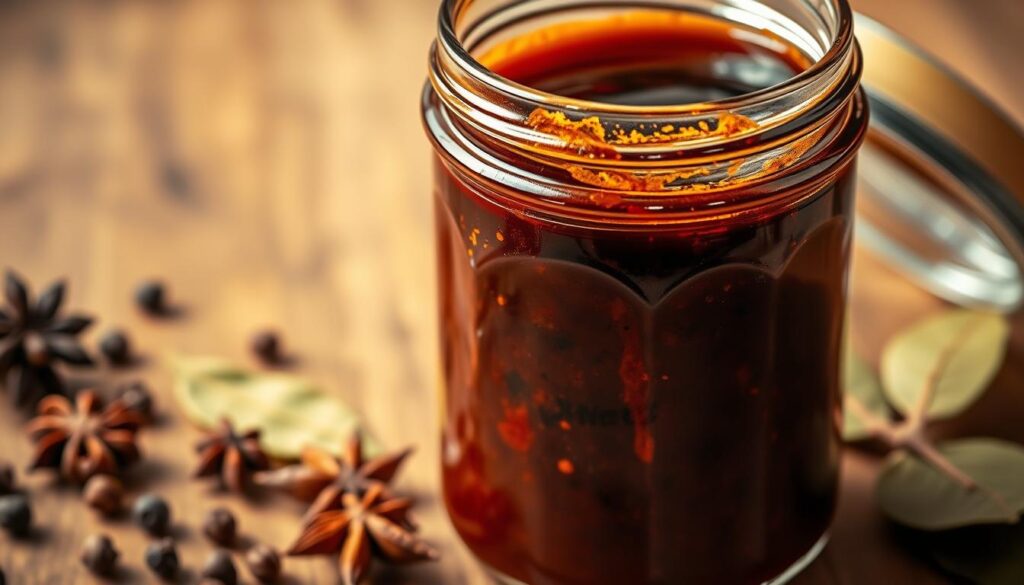
Quick and Easy Versions
For those short on time, there’s a quicker version of Worcestershire sauce that can be made in just 30 minutes.
30-Minute Recipe
This version simplifies the process by using readily available ingredients and reducing the cooking time. Simply blend the ingredients together and simmer for 10-15 minutes.
Customization Options
One of the benefits of making your own Worcestershire sauce is the ability to customize it to your taste.
Spice Level Adjustments
You can adjust the spice level by adding more or less of the cayenne pepper. For a milder sauce, reduce or omit the cayenne pepper.
Dietary Modifications
For a vegan version, replace the anchovy fillets with a suitable alternative, such as seaweed or mushroom-based ingredient.
By making your own Worcestershire sauce, you can ensure that it meets your dietary needs and preferences, making it a great addition to any meal.
The Best Worcestershire Sauce Substitutes
Whether you’re out of Worcestershire sauce or just looking for a different flavor, there are several alternatives available. Worcestershire sauce adds a unique umami flavor to dishes, but when it’s not on hand, various substitutes can step in.
When You’re Out of Worcestershire Sauce
If you find yourself without Worcestershire sauce, don’t panic. There are several alternatives you can use depending on what’s available in your pantry.
Soy Sauce-Based Alternatives
Soy sauce is a common substitute for Worcestershire sauce due to its similar umami flavor profile. You can use it as a 1:1 substitute in many recipes.
- Soy Sauce: A direct substitute with a similar umami taste.
- Tamari: A gluten-free version of soy sauce, ideal for those with dietary restrictions.
- Nama shoyu: A Japanese soy sauce that can add depth to dishes.
Simple Pantry Substitutes
If you don’t have soy sauce, there are other pantry staples that can work as substitutes.
- Miso Paste: Mix with water or broth to create a similar consistency.
- Ketchup and Vinegar: A mixture can mimic some of the tangy, sweet flavors.
- Fish Sauce: Though stronger, it can add a similar umami flavor.
Vegan and Vegetarian Alternatives
For those following a vegan or vegetarian diet, there are specific alternatives that can replace Worcestershire sauce without using animal products.
Commercial Options
Several brands offer vegan Worcestershire sauce or similar products.
- Annie’s Naturals: Offers an organic, vegan Worcestershire sauce.
- Follow Your Heart: Provides a vegan Worcestershire sauce alternative.
DIY Anchovy-Free Recipes
You can also make your own vegan Worcestershire sauce at home.
- Mix together soy sauce, maple syrup, apple cider vinegar, and spices.
- Simmer the mixture to reduce and intensify the flavors.
- Store in the refrigerator for up to a month.
By using these substitutes, you can continue to enhance your dishes even without traditional Worcestershire sauce.
Storing and Using Worcestershire Sauce Properly
To get the most out of your Worcestershire sauce, it’s essential to understand how to store and use it correctly. Proper handling ensures that the sauce retains its complex flavor profile and remains safe to consume.
Shelf Life Guidelines
Worcestershire sauce generally has a long shelf life due to its high acidity and salt content. However, it’s best to check the expiration date on the label. Unopened bottles can typically be stored for up to 3 years in a cool, dark place.
Refrigeration Requirements
Once opened, Worcestershire sauce should be stored in the refrigerator to slow down the degradation process. The cold environment helps preserve the flavor and prevents spoilage.
Signs Your Worcestershire Sauce Has Gone Bad
Check for signs of spoilage, such as an off smell, mold, or an unusual color. If you notice any of these, it’s best to discard the sauce.
Proper Dispensing Techniques
To maintain the quality of the sauce, always tightly seal the bottle after use. Use the original cap or a tight-fitting lid to prevent contamination and exposure to air.
Conclusion: Why Worcestershire Sauce Deserves a Spot in Every Kitchen
Worcestershire sauce is more than just a condiment; it’s a kitchen staple that can elevate a wide range of dishes. As a versatile condiment, it adds depth and complexity to various recipes, from classic meat dishes to innovative vegetarian options.
Throughout this article, we’ve explored the rich history of Worcestershire sauce, its ingredients, and its numerous uses in different cuisines. From enhancing the flavor of soups and stews to adding a unique twist to cocktails, Worcestershire sauce has proven to be a valuable addition to any kitchen.
Whether you’re a seasoned chef or an adventurous home cook, incorporating Worcestershire sauce into your recipes can take your cooking to the next level. With its unique blend of flavors and versatility, it’s no wonder that Worcestershire sauce has become a beloved condiment around the world. Make it a kitchen staple and discover the difference it can make in your cooking.

